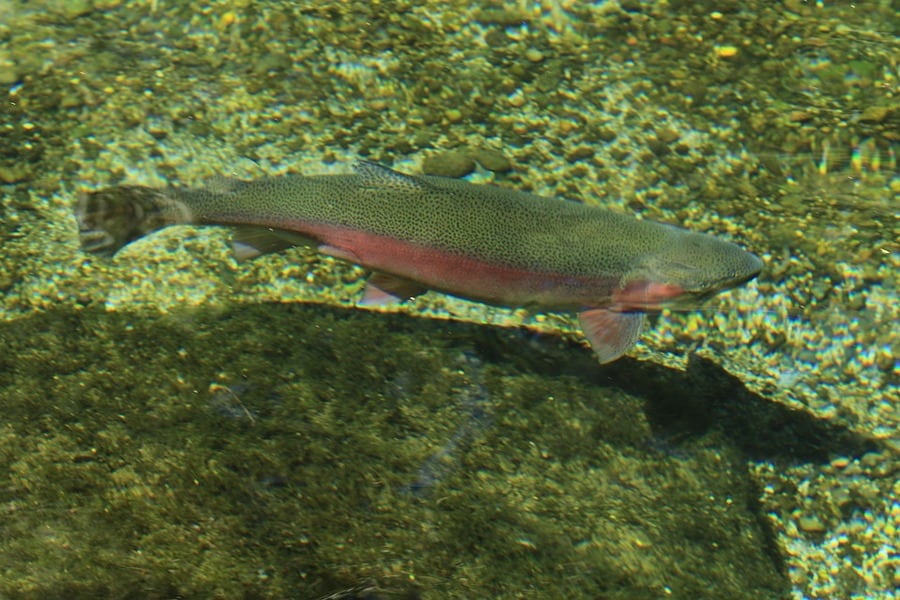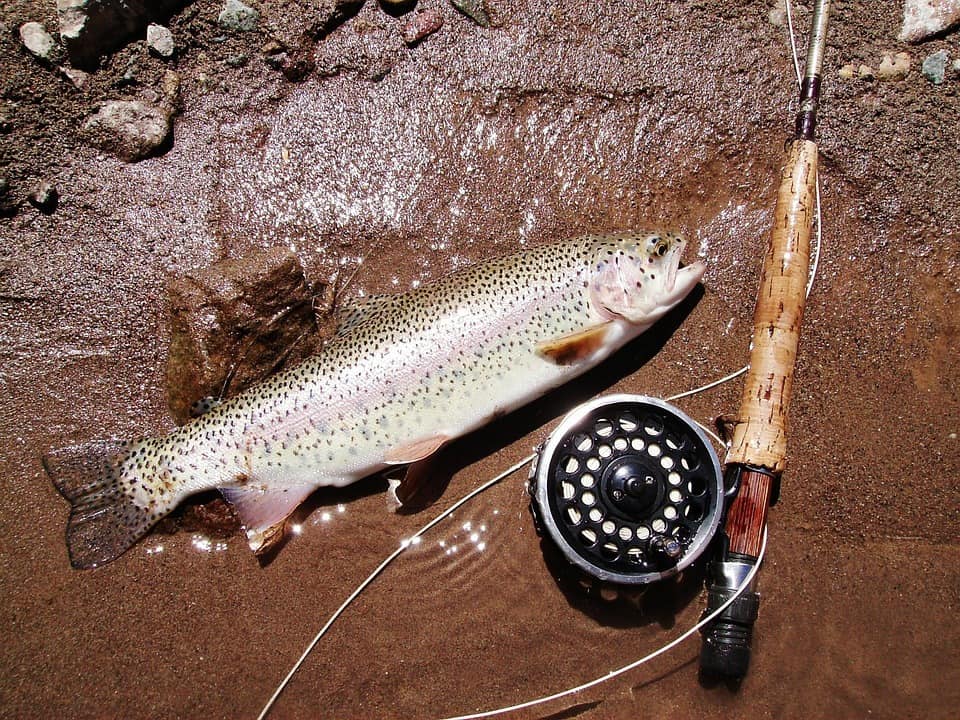Cold Front Trout Fishing (A Complete Guide)
Leave a comment after this article and let’s talk more about trout fishing. I’d love to read your feedback.
Weather plays an enormous role in the location and activity level of trout. Fluctuations in temperature can drive trout to feed voraciously or all but shut down their hunger-drive. Where I live, a cold front pushed in 2 days ago. This got me thinking about how cold fronts affect trout activity and your success fishing for them.
Do cold fronts affect trout fishing? Cold fronts affect trout activity by slowing down their prey items like baitfish, larval insects, and zooplankton. This is in contrast to how voraciously trout feed prior to the cold front in preparation for the in-bound cold air.
I think I need to break this answer down further as there is a great deal of nuance to this situation.

Trout respond very favorably to subtle changes in the relative temperature common for winter and summer. Trout prefer mid-temperature ranges where the water isn’t too cold or too warm.
During the heat of summer, for example, trout are searching for the coolest water they can find. If the regular air temperature is 85 degrees F, even a subtle dip in air temperature by 4 degrees can really spike trout activity.
That is for subtle temperature drops. What about larger drops in temperature caused by the arrival of a cold front where as much as 30 degrees can change within hours.
Trout react to these drastic swings in temperature by hunkering down, slowing their feeding activity, and generally locating deeper pockets of warmer water.
Likewise, in the hours before the cold front arrives, trout will feed aggressively to take advantage of the robust prey availability and to gorge themselves in preparation for the “leaner” times ahead with the colder weather.
Once the cold front rolls in, most trout will hunker down for the first couple of hours but then resume feeding activity. Although they will continue to feed the duration of the cold spell, most of their activity-level will be docile and sluggish.
Their activity levels will spike during the early afternoon when the air temperatures are warmest and if there is any break in the cold spell. Read on to learn all about cold weather trout fishing.
Table of Contents
Cold Front Trout Fishing
What is a Cold Front?
Following a period of warm weather, a cold front is a relatively small boundary between the trailing edge of the retreating warm mass and the leading edge of the advancing cold weather mass.
The cold front represents the transition from warm to cooler temperatures. I am certain weather experts can break this down even further but for the sake of this article, I don’t think any more info is needed.
How Trout Fishing is Affected Pre-Cold Front

Some of the best fishing for trout, and frankly, most species of freshwater fishing is in the days and hours preceding a cold front. This is because prey items like plankton, invertebrates, and baitfish will be out-and-about taking advantage of the remaining warm weather and trout will follow-suit.
They will be eating as much as they can from this buffet line before the cold sets in and prey activity-levels dip down.
If you get word of an approaching cold period in the weather, go hit your local stream, river, or lake, as fishing can be very successful during this time. Trout won’t stop eating once the cold sets in but they will slow way down.
For a complete breakdown of everything you need for trout fishing, click here for my comprehensive trout fishing gear list. I’ll tell you what fly rods, spinning rods, flies, castable fish finders, and waders you need to be more successful than anyone else on the water.
How Trout Fishing is Affected During a Cold Front
Many anglers want to know will trout bite in cold weather. The actual cold front itself may only linger for a couple of hours as it is really the transition from the retreating warm weather and the advancing cold.
During this transition period, you will be a rather abrupt change in the air temperature and oftentimes, a lot of overhead cloud cover reducing sunlight.
During this time of transition, trout will hunker down and remain relatively stationary in deeper water. You can catch trout during this time but the bites will be very tough to come by.
It is my recommendation that you wait at least 2 hours after the start of the cold front to start fishing. You can catch trout but you will have much better success a couple of hours later.
How Trout Fishing is Affected After a Cold Front
Once the initial cold front passes, fishing will begin to pick back up again. Trout will feed throughout the duration of the cold spell, which could last days or even a week.
They will not stop eating but their feeding activity level will slow down and their willingness to chase prey will greatly reduce.
Instead, trout will focus on eating easier prey that comes to them. If you are going to fish with lures like plugs and spoons, slow down your approach. Trout will hit these but their bites will be very subtle and they won’t chase these baits down.
Flies and live bait are tremendous options for these colder windows as trout will readily consume these more natural baits. Furthermore, the current will often draw these baits to the fish, which is exactly what you want when fishing docile trout.
5 Tips for Trout Fishing Around Cold Fronts
1. Flies, Lures, & Bait in Hours Before Cold Front
In the hours preceding a cold front, trout will be feeding aggressively in preparation. Feeding will not stop once the colder air pushes in, but their activity-level and prey availability will reduce. Prey items will hunker down tighter to cover and the bottom making them less vulnerable during the cold front.
Take advantage of the remaining warm hours before the cold front by tossing flies, small lures, and live bait at trout. This is when they will most aggressively feed.
2. Wait 2 hours After Cold Front Moves In
Once the initial wave of the cold front moves in, give trout about 1-2 hours to adjust before fishing for them. That first wave of cold air will be a shock to the entire system.
Trout will often not eat anything until at least an hour after the cold front so do not fish for them when they won’t eat.
3. Fish Slow During Cold Front
Trout will be more docile during the cold front. They will continue to eat but their bites will not as aggressive and decisive. When a trout takes your bait, they may not hold onto it. Y
ou have to watch your line for subtle bites and set the hook as soon as you see the line twitch or you are likely to miss them. Furthermore, you need to slow down your presentation. Fish flies slower and let the bait sit longer.
4. Following the Cold Front, Fish Midday
Trout will be most active during the warmest parts of the day once the cold settles in. Most often, midday through the early afternoon is the warmest periods. Even temperatures 3-5 degrees warmer will really spike up trout action.
5. Nymphs and Sinking Baits for Cold Weather Trout
Trout will often hunker down near the bottom when the weather turns cold. As a result, present them with baits like nymphs and sinking spinners or spoons to reach these fish deeper in the water column.
How Minor Drops in Temperature Can Affect Trout Fishing

We have already established that trout respond directly to drastic changes in temperature associated with cold fronts.
However, what about much more subtle dips in temperature that occur daily and even weekly? These minor alterations in air and water temperature can have big impacts on how active trout become.
During the summer when the weather is hot and muggy, trout will be desperately seeking out the coolest water they can find.
This is because trout do not do well in warm water, colder water has more dissolved oxygen and nutrients, and prey items will be more plentiful here. Even slight dips in temperature of a few degrees can have large effects on your trout fishing success.
Trout are visual predators, which means they do most of their feeding during the day when they can better see their prey items. Look for times throughout the day when the water temperature will be coolest but there is still ample sunlight for these visual predators to hunt.
There are natural dips in temperature that will produce a spike in trout activity and feeding. Early morning and near sunset are 2 prime examples of great fishing times to catch trout. Patterning these subtle temperature fluctuations can produce great results for anglers.
Conclusion
Trout fishing can be very successful in and around cold fronts. Fishing action will be hottest before the cold front but during and after can be good as well. Just make sure once the cold arrives, you slow down and be ready to set the hook quickly on indecisive fish.
Frequently Asked Questions
Do trout bite in cold weather?
Trout are known to bite in cold weather, although their activity may decrease. As cold-blooded creatures, trout’s metabolism slows down in colder temperatures, making them less active. However, they can still be caught with proper techniques and bait. Using slow retrieves and opting for live bait or lures that mimic natural prey can increase chances of success.
How cold is too cold for trout?
Trout are cold-water fish that thrive in temperatures between 50 to 60 degrees Fahrenheit. However, they can withstand colder temperatures down to the freezing point. When water temperatures drop below 40 degrees, trout become less active and may struggle to find food. So, generally, anything below 40 degrees Fahrenheit could be considered too cold for trout.
Do trout like cold weather?
Trout thrive in cold weather as they are cold-water fish. They prefer temperatures between 50-60 degrees Fahrenheit. Cold weather stimulates their metabolism and increases their appetite, leading to more active feeding. So, yes, trout do like cold weather for optimal growth and activity.
Do trout go deeper in cold weather?
During cold weather, trout tend to go deeper in search of warmer water. Cold temperatures affect their metabolism, slowing it down. As a result, they seek deeper areas where the water is relatively warmer. Deeper water also provides shelter from harsh weather conditions.
Are trout more active in cold weather?
Trout are more active in cold water due to their physiology. Cold water contains more oxygen, allowing trout to thrive and engage in higher activity levels. Additionally, lower water temperatures stimulate their metabolism, increasing their feeding and movement. This makes cold water an ideal environment for trout to exhibit their energetic behaviors.
